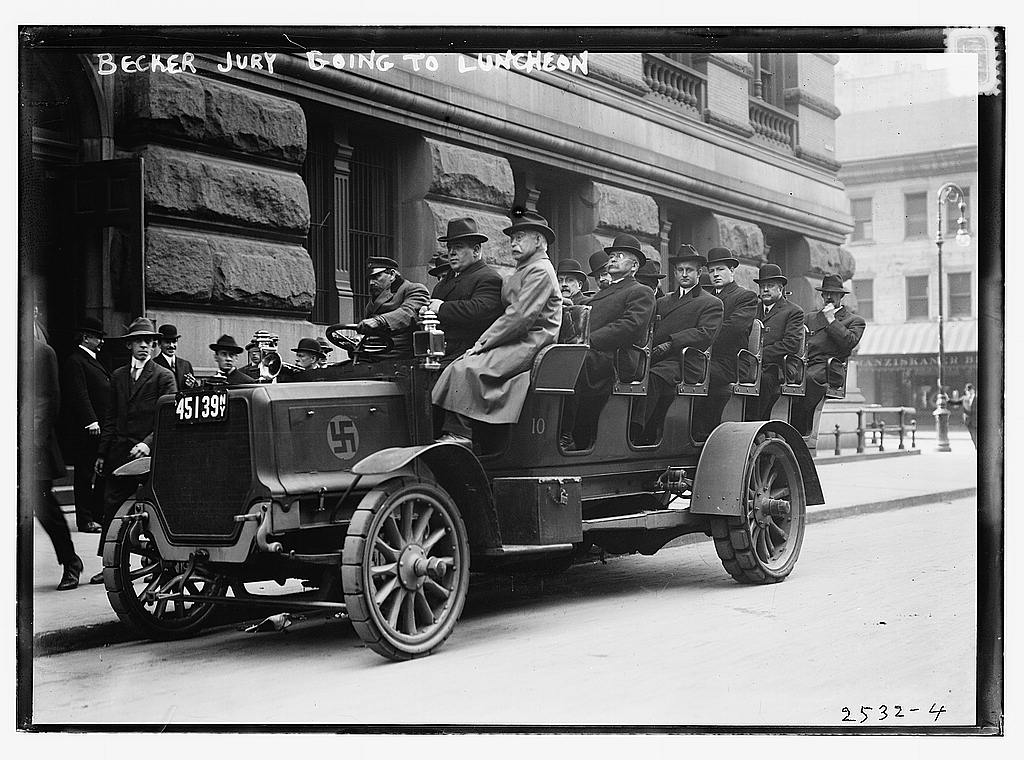 |
| Ford branch office circa 1914. Photo from "The First Century of the Detroit Auto Show" |
By 1914, Detroit is already on its 13th annual auto show. The first three floors of the Ford branch building on Woodward and Boulevard (aka Grand Boulevard) host 41 brands of "gasoline pleasure cars", 6 makes of commercial vehicles, an array of accessories (e.g., electric cranks, radiators), and a smattering of motorcycles. All told, $1 million worth of autos ($22 million in 2012 dollars) are on display, and these are just a sampling of the 395,000 autos that Detroit expects to crank out this year.
 |
| Notice the logo on the side panel of the hood? This was well before Hitler's time, when the swastika was still considered a symbol of luck and was adopted by marketers of everything from laundromats to Coca Cola. Here, it is the emblem of the Krit brand of motor cars. Photo from the Library of Congress |
Despite inclement weather, opening day shatters attendance records. The original plan had been to send visitors, immediately on arrival, up the elevator and then steer them slowly through the exhibits and down the stairs towards the exit. But when 18,000 people descend on the Ford building on the first night alone, the plan is scrapped for fear of elevator accidents.
Favorite local singers and orchestras keep the mood lively and the crowds moving through a "fairyland of light". Schmemann's Military Band (formed originally as the musical arm of the Civil War regiment known as the Detroit Light Guard, which by the way was also know as "The Tigers" and is the very same from which our beloved baseball team took its name), the Ben Shook Orchestra (a "Negro" ragtime group which recently split off from Finney's Orchestra in the wake of a power struggle after the conductor's recent death), and Frankenstein's Band each fill a floor with toe tapping tunes.
A shiny, new motor cars can set a middle class person back a full year's salary. There is no such thing as a car loan in 1914, and so some dealers accept as payment livestock, jewelry, and appraised property. Elsewhere in America, unemployment is high and people are feeling the pain of one year in of a sharp, two-year recession. But, in Detroit, times are good and getting better. An annual salary, of say, $15,000 ($335,000 in 2012 dollars) puts one in easy reach of this prized possession. "Society Night" (when the price of admission is doubled and women of means dress in gowns and furs, hoping to be appreciated as much as the motor cars) rakes in beaucoup bucks. But for the regular oglers, the merchandise is lookee-no-touchee.
The 1914 auto show (and the scene it creates) is so invigorating and successful that the following years will see it get a Steve Ballmer-style touch. The following year's attractions would include airplane acrobatics over the river and wandering, scantily clad "cigarette girls" advertising automobile accessories and distributing catalogs. By 1916 the show would be so massive that it is split across three local ballrooms, one of which is at a local amusement park, only adding to the manic fervor.
The First Century of the Detroit Auto Show" by Robert Szudak for much of the info reported here.


No comments:
Post a Comment